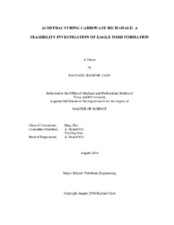| dc.description.abstract | Due to the extensive technically recoverable shale natural gas resources and an increase in production from shale plays over the last 10 years, it is essential to focus on stimulation techniques to enhance productivity in shale resources. One such stimulation technique is acid fracturing. Similar to hydraulic fracturing, acid fracturing injects acid into a formation at a pressure greater than the fracture pressure, creating fractures and etching the created fracture face. The high carbonate content of the Eagle Ford Shale makes the formation a possible acid fracturing candidate. Minimal research has been completed on the effects of acid fracturing high carbonate-containing shale formations, where various conditions can limit the permeability of petroleum fluids. In this study, eight Eagle Ford shale samples, four from Zone C and four from Zone D, are used to determine the effect of surface etching pattern, acid concentration, calcite content, and Brinell Hardness Number on created acid fracture conductivity in the Eagle Ford shale.
The resultant surface etching volume is determined by a pre-and post-surface Profilometer scan to calculate the change in surface profile. Calcite content is determined by X-Ray Diffraction analyses. Conductivity tests are performed on the eight samples up to a closure stress of 4000 psi, sample integrity permitting.
Based on the results determined in this study, acid fracturing the Eagle Ford shale could provide optimistic increases in production. Acid fracturing treatments in high calcite containing zones of the Eagle Ford shale are expected to result in an increase in productivity. For the Eagle Ford Shale, the surface etching patterns that result in highly sustained conductivity values are channeling and roughness. A direct correlation is shown between calcite content of the shale and resultant surface etching volume. Furthermore, the higher the calcite content of the samples, the more likely the etching pattern will result in channeling and surface roughness. Brinell Hardness tests are completed on Eagle Ford samples determining that, on average, the higher the Brinell Hardness number, the better resulting surface etching pattern and sustained acid fracture conductivity. | en |


